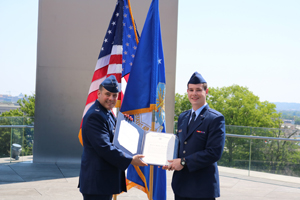UMD Atmospheric and Oceanic Science Alumnus C.J. Vernon Rises Above
Vernon, who is training to be a drone pilot in the U.S. Air Force, published a first-author paper on his senior thesis research
U.S. Air Force 2nd Lt. Charles Justin “CJ” Vernon (B.S. ’17, atmospheric and oceanic science) spent the summer after his freshman year interning at Naval Air Station Patuxent River in southern Maryland. A University of Maryland engineering major at the time, Vernon helped design and engineer a buoy sonar system. But it was the constant sight of planes taking off and landing that changed his long-term career plans.
 “There was a flying club on base, and I decided to try it out. That made me fall in love with flying,” said Vernon, who counts “Top Gun”—which features U.S. Navy pilots in training—among his favorite movies.
“There was a flying club on base, and I decided to try it out. That made me fall in love with flying,” said Vernon, who counts “Top Gun”—which features U.S. Navy pilots in training—among his favorite movies.
Vernon returned to campus in the fall and joined the university’s Air Force ROTC program. He also changed majors to atmospheric and oceanic science after taking the course AOSC 200: “Weather and Climate” with Timothy Canty, an associate research professor of atmospheric and oceanic science at UMD.
“He was one of the best professors I ever had,” Vernon said. “He brought in machines to generate tornadoes and electricity to show us how thunderstorms and tornadoes worked.”
When it came time for Vernon to pick a topic for his senior thesis, Canty suggested that Vernon work with Ralph Kahn, a senior research scientist at NASA’s Goddard Space Flight Center. At first, Vernon digitized and entered data from NASA satellite instruments including the Multi-angle Imaging Spectroradiometer, which collects climate data such as cloud cover and aerosol particles.
Then, Vernon became interested in forecasting the dispersal of smoke, ash and other particles that events such as wildfires and volcanic eruptions eject into the atmosphere. Forecasting the dispersal of these particles is important because the particles contribute to air pollution.
As Vernon studied several forecast models for simulating particle dispersal, he noticed that the models use internal processes to predict an event’s injection height, which is the highest point that the particles from the event reach before they begin to disperse in the atmosphere. This gave Vernon an idea for his thesis project.
“All the models have specific processes that they use to estimate the injection height on their own, but by checking satellite data, we get actual measurements,” Vernon said. “We wanted to see if we could improve the forecast by using the measurements.”
Vernon, Kahn and Ryan Bolt (B.S. ’17, atmospheric and oceanic science) tested the theory on the National Oceanic and Atmospheric Administration’s Hybrid Single-Particle Lagrangian Integrated Trajectory (HYSPLIT) model, one of the most extensively used atmospheric transport and dispersion models.
The researchers found that using injection height data in the HYSPLIT model improved the forecast accuracy in four out of six real-world wildfire or volcanic eruption events. The improvement was greatest when the injection height was above the planetary boundary layer, which is the lowest part of Earth’s atmosphere. In addition, using actual injection data improved wildfire forecasts more than volcanic eruption forecasts, because HYSPLIT tended to underestimate the injection height of wildfire events that the researchers studied.
“Doing the project was incredibly challenging,” Vernon said. “HYSPLIT is an amazing model, but it is also very complex and I spent hours in the computer lab learning to work with it.”
Vernon’s hard work paid off when the work received the department’s best undergraduate thesis award, which led the team to submit the work for publication in a peer-reviewed journal. Writing the paper presented Vernon with a different set of challenges.
“We went through about nine drafts before I sent it out for peer review, three drafts during peer review and two more drafts before it was accepted for publication,” Vernon said. “Even within the past year, while I was training to fly drones, I was trying to respond to comments on the draft.”
The study was published in the journal Atmospheric Measurement Techniques on November 21, 2018, with Vernon as the first author.
“CJ has a drive and determination to solve problems, which made working with him very enjoyable,” said Canty, who was also a co-author on the publication. “I look forward to collaborating with him in the future.”
After Vernon completes his drone pilot training and receives his “wings,” he will serve in the Air Force for at least six years. Although he does not know where his career will take him, Vernon says he would like to return to studying the atmospheric sciences in the future.
“The idea of using my experience as a drone pilot in combination with research is exciting,” Vernon said. “For instance, NASA flies their own drones now to do atmospheric research. Getting involved in that would be wonderful.”
###
The research paper, “The impact of MISR-derived injection height initialization on wildfire and volcanic plume dispersion in the HYSPLIT model,” Charles Vernon, Ryan Bolt, Timothy Canty and Ralph Kahn was published in the journal Atmospheric Measurement Techniques on November 21, 2018.
Media Relations Contact: Irene Ying, 301-405-5204, zying@umd.edu
University of Maryland
College of Computer, Mathematical, and Natural Sciences
2300 Symons Hall
College Park, MD 20742
www.cmns.umd.edu
@UMDscience
About the College of Computer, Mathematical, and Natural Sciences
The College of Computer, Mathematical, and Natural Sciences at the University of Maryland educates more than 9,000 future scientific leaders in its undergraduate and graduate programs each year. The college’s 10 departments and more than a dozen interdisciplinary research centers foster scientific discovery with annual sponsored research funding exceeding $175 million.


